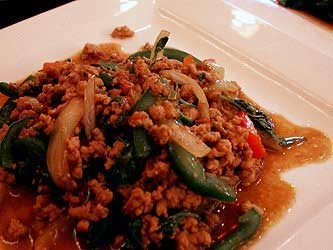 |
1) A Symphony of Flavors
Like a finely tuned orchestra, the flavors in Thai cooking must strike a perfect balance. Salty, spicy, sour, and sweet are the primary instruments. But, as most Thai chefs will surely tell you, getting the combinations right (or harmony, if you will) takes lots of practice. The flavor profiles are intentionally distinct, and some of the nuances are subtle, yet balance is paramount for the success of a dish. Think about pad Thai. This extremely popular noodle dish (at least for Americans) is the epitome of balanced flavors and textures: the softness of the rice noodles in contrast to the crunchy peanuts; the tanginess of the fish sauce interplaying with sweet chili sauce, and so on. You get the idea.
2) Cooking With Color
Thailand is a colorful place. The open-air markets burst in a flourish of color, with a seemingly never-ending profusion of fresh produce and spices–ingredients that are integral to Thai cuisine. The Thais like to incorporate color into their dishes, as part of the ultimate balance of the food. Some Thai dishes often look too beautiful to eat, but they are usually as tasty as they appear. Spicy beef salad (yum beef), for example, is a bright amalgamation of zesty grilled beef, tomato, scallion, cucumber, and fresh herbs. Sounds yum-yum yummy.
3) The South Means Seafood
Besides a bounty of fresh seafood, southern Thailand is known for its coconut trees. So it’s no surprise that the cuisine from this touristy region features seafood and coconut-related dishes. Most of the curries that hail from this region are infused with coconut milk. Mussaman, an aromatic Indian-style curry, is a typical seafood stew that gets dished up in the scorching south. Since this area is so strongly influenced by the Indian culture (and the Muslim culture, as well), it’s not uncommon to find ingredients such as cardamom, cumin, cinnamon, and mustard seed–fused with the likes of lemongrass, galangal root, and fiery chilies.
4) Green Curry Central
Most Thai restaurants in America specialize in the cuisine from the central plains of Thailand, which is where the booming metropolis of Bangkok is located–on the southern fringe of the region. Dishes such as minced pork omelets, green curry stew, pineapple fried rice, and shrimp soup with lemongrass are commonplace here. Noodles also can be found throughout the region, especially the ubiquitous duck and noodle soup. Aromatic jasmine rice is the preferred side dish in the central area.
5) Way Up North
Chiang Mai, the largest city in mountainous northern Thailand, is known for its Burmese-influenced curries, nam prik (pungent chili paste), sticky rice, and noodle dishes. Wide rice noodles (drunken noodles), entangled with julienne pepper, onion, and fresh basil leaves, are popular up north. The northern Thais also like sai ua, a fragrant pork sausage redolent of lime leaves (kaffir), garlic, chilies, and lemongrass. Most cooks in the north adhere to the salty, spicy, and sour rule, yet the sweet component often gets left out of the flavor profile.
6) North By Northeast
The cuisine of northeast Thailand is distinct from the other three regional cuisines. It’s safe to say that the country’s barbecue fanatics reside in this region, which borders with Laos, as evidenced by the profusion of satay and other grilled dishes. Northeast Thailand is known for gai yaang–barbecued chicken that’s been marinated in lemongrass, coriander, and lots of garlic (often served with zesty tamarind sauce). Another mainstay dish is a piquant shredded green papaya salad known as som tum, which goes well with grilled bat on a stick–a Laotian thing.
7) Thais Don’t Use Chopsticks! Wrong!
There’s a common misconception among westerners that Thai people only use forks and not chopsticks, which are used in Thailand’s neighboring countries. This is true to a certain degree, but Thais sometimes use chopsticks when eating noodle dishes. It’s not uncommon to find buckets of chopsticks in noodle houses. Yet the fork and spoon are still the preferred dining utensils in the land of Siam–this is true.
